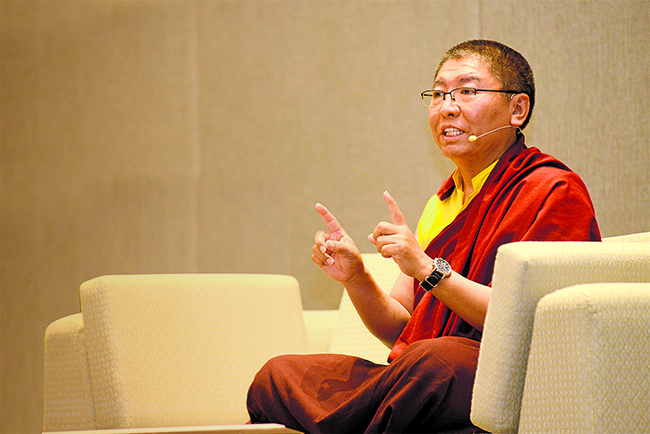For quite some time now management experts have been considering holistic issues like wellbeing, work-life balance, and stress management at work apart from productivity and efficiency.
In an interview with American business portal Business Insider, Jeff Bezos, the richest man on earth, said: “If I’m happy at home, I come into the office with tremendous energy. And if I’m happy at work, I come home with tremendous energy.”
 “What’s inside you is reflected outside,” said Tsoknyi Rinpoche, a well-known Buddhist master, who was in Kathmandu recently. “That’s why we are looking to remain relaxed and joyful within.”
“What’s inside you is reflected outside,” said Tsoknyi Rinpoche, a well-known Buddhist master, who was in Kathmandu recently. “That’s why we are looking to remain relaxed and joyful within.”
But how would anyone accomplish anything if one were to be ‘relaxed’ in this fast-paced world?
Rinpoche clarified: “But we shouldn’t be too relaxed outside in the physical world. If we do that, we won’t be able to do or accomplish anything.”
“Relaxed inside, but speedy at work. That is what we need,” he explained.
Talking to an audience of entrepreneurs and professionals from various walks of life at the Hyatt Regency Hotel, he said: “I have many students who are successful but feel hollow inside. And there are many who are very happy inside, but not so successful. So the challenge is: how do you balance it?”
“Successful life outside and fulfillment inside, aren’t we all looking for that?” said Rinpoche, a highly revered reincarnate lama and author of three international bestsellers—Open Heart Open Mind, Carefree Dignity, and Fearless Simplicity.
In nearly an hour-long talk, Rinpoche explained how one could achieve ‘success’ in the external world and remain joyful and relaxed inside. He also conducted a 10-minute meditation session so the audience could learn a basic technique to turn within and relax.
Government cash balance stands at Rs 65.81 billion

To be happy, one could become a recluse and shun the world and seek his/her own wellbeing. But that doesn’t work for the people in the modern world. “I don’t think many of us can do that,” Rinpoche said.
Three types of speed
“We need certain speed and restlessness, or stress, to accomplish things in the world,” Rinpoche said. “Stress is related to speed. Without losing our inner joy, we need to be able to cope with the stress and speed of the world.”
Rinpoche said it was necessary to balance between the two extremes: the Nepali-style laid-back attitude leading to internal relaxation but external non-accomplishment; and the western-style need-to-do-it-fast attitude leading to external speed and internal stress at the same time.
He cited three types of speed—at the levels of body, cognition, and feelings.
The speed of body is easy enough to understand—it is the speed through with our bodies and faculties get something done. Similarly, we also have speed of cognition: when someone tells us a joke, we laugh instantly. When we are constantly urged by our feeling to get things done or wish for something to happen that is the speed of our feelings.
“We require the speed of the body. Otherwise nothing gets done. We also require the speed of cognition. Otherwise we may laugh one minute after someone tells us a joke. That’s not good,”
Rinpoche explained. “We just don’t need the speed of feelings and emotions. It causes us stress. It’s like you have a flight three days later, but your feeling already makes you restless—you have to take the flight, you have to get it done quickly. It’s not going to help.”
Rinpoche gave a real-life example about handling things at the outer and inner levels. When someone gives you the task of cleaning a room, there are three scenarios. First, you see the room, and tell the other person, “I will let you know”. The chances are, you never start the work or even if you start, you will not finish it. Second, you say maybe it will take two hours and start working. But you are feeling restless, you want to complete the task and leave the room as soon as possible. You get it done on time, but develop tremendous stress. Third, you are cleaning the room at the required speed, and have a feeling inside along the lines of “Wow, I’m doing it and it’s getting done. Who cares about anything else.”
The first, Rinpoche described, was a laid-back approach that would help nobody. The second was the modern hyper-stressed approach that would leave you hollow even if you accomplish the task. The third was the approach that would see the task accomplished and leave you relaxed and fulfilled as well.
“An ideal situation is a Nepali-style relaxation inside, and New York-style stress outside,” Rinpoche concluded.
Subtle body at work
Say it takes two hours for you to do something and you start working. The feeling or the emotional mind starts telling you: “Why two hours, do it fast, do it faster and get out of this room.” You become restless. This restlessness, or anxiety, happens at our feelings level. It’s like a continuous banging on the door. This restlessness of feeling causes us stress, not the physical speed.
“That restlessness of feeling happens at the level of ‘prana’, or ‘chi’ as the Chinese call it. In Tibetan we call it ‘loon’,” Rinpoche explained. “We all have a subtle body that is beyond the mind and the physical body. In the subtle body we have prana, bindu and nadi. Prana keeps pushing at the channels, or nadis, and that gives you the feeling of pressure. The pressure expresses itself through your physical body – your face is hot and your forehead is almost burning, your mouth dries and so on. Then everything is like—where is the next moment? This moment is not right. I’m looking for the next moment. This moment is not okay, an okay moment will come tomorrow or the next day.”
According to him, we keep running away from the present moment, looking for the future. We assume the future will be perfect. But that never happens. Eventually, there are many imprints left in our channels.
“We have imprints coming from our histories, memories, experiences. If we don’t know our imprints, we are shattered when the prana provokes them,” Rinpoche said adding that mindful awareness is the best way to deal with these imprints – awareness of your worlds – physical world, subtle body world, emotional world. When you are mindfully aware, you keep with the speed, because you have to finish the task. But within, you can maintain your calm because you recognize your inner nature.
“By the practice of awareness, you can talk to your prana and tell it to relax. That feeling of ‘who cares!’ then comes to you,” concluded Rinpoche.
poudel.arun@gmail.com


































